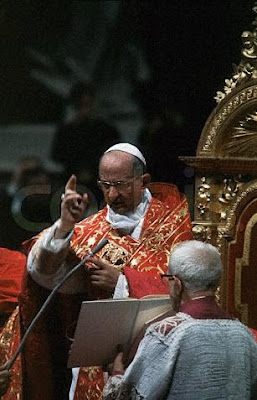When looking at works of (Western) sacred art or old photographs of ecclesiastical occasions and figures, one thing one notices is that whenever the gesture of blessing is shown (outside of Mass itself), bishops, popes, Saints, and even God Himself (or His isolated hand in the motif of the Hand of God) are shown holding their right hand in a specific manner: thumb, index and middle finger extended, while ring and little finger are bent backwards. This gesture has become archteypical in the West as the Latin gesture of benediction. A very clear example can be seen in the coat of arms of Heiligenkreuz Abbey:
Since the occurences in works of art are countless, I will just show you some very few examples from different periods.
The Hand of God in a codex of St. Gregory the Great's Moralia in Job from Bamberg, 11th c.:
A reliquary of St. Thomas a Becket from Limoges, 13th c.:
Dürer's Salvator Mundi, c. 1504:
A crucifixion from the Beuron school of art:
Whereas for the final blessing of the Mass, the rubrics prescribe a blessing with the hand extended and the fingers joined ("extensa manu dextera iunctisque digitis", ritus servandus XII, 1, which according to references I have found goes back to St. Pius V), whenever we see pictures of blessings outside Mass, the Latin gesture of benediction is the one employed. The most prominent example are the popes, who also used to give the blessing urbi et orbi in this manner. And having their hands raised in this gesture of benediction became the customary way of being depicted in official portraits.
Here is a gallery of popes blessing this way.
St. Peter (in his most famous representation in the Vatican Basilica):
Benedict XIII:
Clement XIII:
Benedict XV:
Bl. Pius IX:
Pius XI:
Ven. Pius XII:

Bl. John XXIII:
Paul VI:

John Paul I:
Ven. John Paul II:
There is also video showing this. Here we see Benedict XV (obviously the speed, typically for film recordings of that time, does not correspond to the real speed):
Pius XII, giving the Easter urbi et orbi blessing:
And again Paul VI in the beatification of St. Charbel Makhlouf which we discussed recently (the blessing is approximately at minute 3:00):
As mentioned, the gesture was, of course, not limited to the popes. Here are some select examples of bishops.
Cardinal Léger, Archbishop of Montreal from 1950 to 1968:

Cardinal Ursi, Archbishop of Naples from 1966 to 1987:

Cardinal Quiroga Palacios, Archbishop of Santiago de Compostela from 1949 to 1971:

Archbishop Fulton Sheen:

In one of the inexplicable developments after the II Vatican Council, the practice has widely disappeared, without having ever been - as far as I am aware - officially discouraged, let alone abolished. It has not, however, died out entirely, as you can see from this photograph of the abbot of Heiligenkreuz, Count Henckel-Donnersmarck:

Also, very interstingly, Archbishop Dolan of New York is, on his official portrait as Archbishop of Milwaukee, represented as blessing in this form:

if you know of other examples of current use this gesture, I would appreciate it if you would send them in.
In any case, given the deep rootedness of the Latin gesture of benediction in our tradition, and the rich theological interpretation which has been attributed to it afterwards of referring to the Three Persons of the Godhead (three extended fingers) and the two natures of Christ (two finger folded back), it would seem highly desirable if it could be returned to wider use, especially since no piece of current legislation seems to prevent that. This would ideally include a return of the papal practice as well. Interestingly, it has not completely disappeared from papal imagery either; see for example this medal of Pope Benedict distributed during World Youth Day 2008 in Sydney:

The Holy Father himself is of course well aware of this gesture, as can be seen from this most intersting video, which was taken during his summer holiday in Brixen, South Tyrol, also in 2008 (no embedding possible): http://www.kathtube.com/player.php?id=5267
In it, wee see Pope Benedict with his brother, Msgr. Georg Ratzinger, and his secretray, Msgr. Georg Gänswein, before a statue of Our Lady in the garden of the seminary of Brixen. This statue shows Our Lady teaching the Infant Lord Jesus how to bless, employing precisely the Latin gesture of benediction, which the Pope explains, repeating this gesture.
fonte:new liturgical movement

 inundado por um mistério de luz que é Deus e N´Ele vi e ouvi -A ponta da lança como chama que se desprende, toca o eixo da terra, – Ela estremece: montanhas, cidades, vilas e aldeias com os seus moradores são sepultados. - O mar, os rios e as nuvens saem dos seus limites, transbordam, inundam e arrastam consigo num redemoinho, moradias e gente em número que não se pode contar , é a purificação do mundo pelo pecado em que se mergulha. - O ódio, a ambição provocam a guerra destruidora! - Depois senti no palpitar acelerado do coração e no meu espírito o eco duma voz suave que dizia: – No tempo, uma só Fé, um só Batismo, uma só Igreja, Santa, Católica, Apostólica: - Na eternidade, o Céu!
inundado por um mistério de luz que é Deus e N´Ele vi e ouvi -A ponta da lança como chama que se desprende, toca o eixo da terra, – Ela estremece: montanhas, cidades, vilas e aldeias com os seus moradores são sepultados. - O mar, os rios e as nuvens saem dos seus limites, transbordam, inundam e arrastam consigo num redemoinho, moradias e gente em número que não se pode contar , é a purificação do mundo pelo pecado em que se mergulha. - O ódio, a ambição provocam a guerra destruidora! - Depois senti no palpitar acelerado do coração e no meu espírito o eco duma voz suave que dizia: – No tempo, uma só Fé, um só Batismo, uma só Igreja, Santa, Católica, Apostólica: - Na eternidade, o Céu!